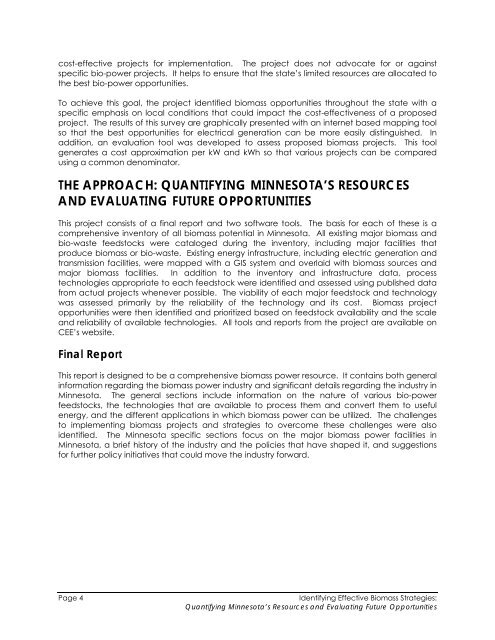Biomass Feasibility Project Final Report - Xcel Energy
Biomass Feasibility Project Final Report - Xcel Energy
Biomass Feasibility Project Final Report - Xcel Energy
Create successful ePaper yourself
Turn your PDF publications into a flip-book with our unique Google optimized e-Paper software.
cost-effective projects for implementation. The project does not advocate for or against<br />
specific bio-power projects. It helps to ensure that the state’s limited resources are allocated to<br />
the best bio-power opportunities.<br />
To achieve this goal, the project identified biomass opportunities throughout the state with a<br />
specific emphasis on local conditions that could impact the cost-effectiveness of a proposed<br />
project. The results of this survey are graphically presented with an internet based mapping tool<br />
so that the best opportunities for electrical generation can be more easily distinguished. In<br />
addition, an evaluation tool was developed to assess proposed biomass projects. This tool<br />
generates a cost approximation per kW and kWh so that various projects can be compared<br />
using a common denominator.<br />
THE APPROACH: QUANTIFYING MINNESOTA’S RESOURCES<br />
AND EVALUATING FUTURE OPPORTUNITIES<br />
This project consists of a final report and two software tools. The basis for each of these is a<br />
comprehensive inventory of all biomass potential in Minnesota. All existing major biomass and<br />
bio-waste feedstocks were cataloged during the inventory, including major facilities that<br />
produce biomass or bio-waste. Existing energy infrastructure, including electric generation and<br />
transmission facilities, were mapped with a GIS system and overlaid with biomass sources and<br />
major biomass facilities. In addition to the inventory and infrastructure data, process<br />
technologies appropriate to each feedstock were identified and assessed using published data<br />
from actual projects whenever possible. The viability of each major feedstock and technology<br />
was assessed primarily by the reliability of the technology and its cost. <strong>Biomass</strong> project<br />
opportunities were then identified and prioritized based on feedstock availability and the scale<br />
and reliability of available technologies. All tools and reports from the project are available on<br />
CEE’s website.<br />
<strong>Final</strong> <strong>Report</strong><br />
This report is designed to be a comprehensive biomass power resource. It contains both general<br />
information regarding the biomass power industry and significant details regarding the industry in<br />
Minnesota. The general sections include information on the nature of various bio-power<br />
feedstocks, the technologies that are available to process them and convert them to useful<br />
energy, and the different applications in which biomass power can be utilized. The challenges<br />
to implementing biomass projects and strategies to overcome these challenges were also<br />
identified. The Minnesota specific sections focus on the major biomass power facilities in<br />
Minnesota, a brief history of the industry and the policies that have shaped it, and suggestions<br />
for further policy initiatives that could move the industry forward.<br />
Page 4<br />
Identifying Effective <strong>Biomass</strong> Strategies:<br />
Quantifying Minnesota’s Resources and Evaluating Future Opportunities

















